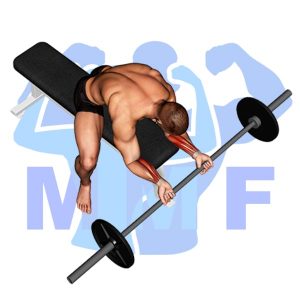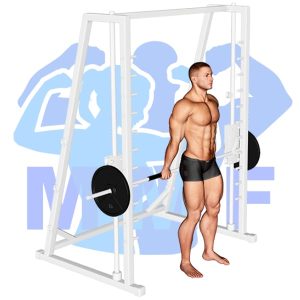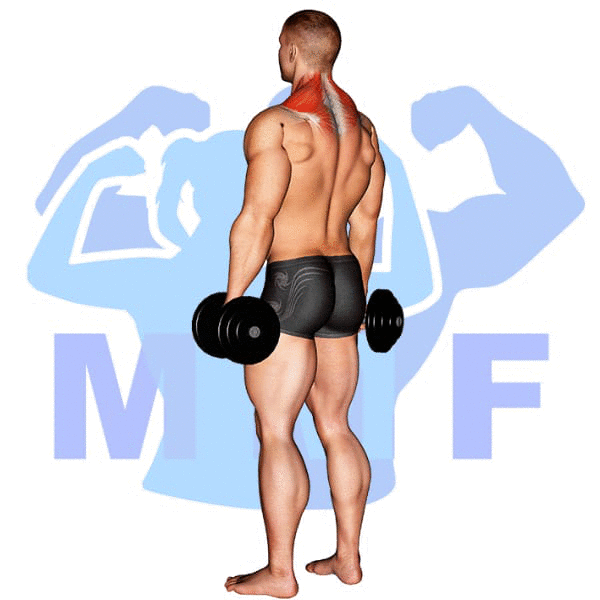If you are struggling with grip strength during your workouts, you may have heard of the barbell behind finger curl. It’s a well-known exercise that targets the muscles in your forearms and helps increase your grip strength. However, if you find yourself unable to perform this exercise properly or without pain, know that you’re not alone. Many people struggle with grip strength, and the root cause is often due to weak forearms from lack of exercise or improper form. Don’t give up just yet though! In this post, we will guide you through everything you need to know about the barbell behind finger curl, including tips and techniques for proper execution, and how to avoid common mistakes that can lead to injury. With patience and consistency, you’ll be able to strengthen your grip in no time!
Barbell Behind Finger Curl Summary
- Primary Muscles: Wrist Flexors
- Secondary Muscles: None
- Equipment: Barbell
- Mechanics Type: Isolation
- Force: Pull
- Utility: Auxiliary

Barbell Behind Finger Curl Instructions
- Grab the bar behind your back, palms facing away, with your body-centered.
- Allow the bar to roll down to your fingertips, without dropping the bar.
- Then curl the bar back up with your fingers until the bar touches your palm.
- Repeat for your desired number of reps.
Video Tutorial
Barbell Behind Finger Curl Muscles
Target (Agonist)
Synergists
- None
Dynamic Stabilizers
- None
Stabilizers
- None
Antagonist Stabilizers
- None

Benefits of Barbell Behind Finger Curl
The Barbell Behind Finger Curl is an effective exercise for strengthening the wrist flexors. This exercise involves gripping a barbell behind your fingers and curling it up towards your body. The movement of this exercise focuses on the muscles in the wrist, namely the wrist flexors, helping to increase their strength and size. Not only does this exercise help to build muscle strength, it also helps to improve coordination and stability in the wrists. Additionally, it can improve joint flexibility, making it an ideal exercise for overall wrist health and injury prevention.
Tips for Performing Barbell Behind Finger Curl
Now that you know more about the barbell behind finger curl, it’s time to put this knowledge into practice. To help you get the most out of this exercise, here are some tips to keep in mind.
- Do Power Sets. Is executing a set of a couple of totally different lifts consecutive. Furthermore, there are a couple of main ways to perform power sets, the primary is to target one muscle. The other is to focus on the opposite muscle groups.
- Keep A Working Out Record. You should certainly have a journal of all weights, sets, and repetitions. When you are top of the class you will in addition note your rest times. Now there are plenty of nice apps to use a journal, or you could simply try a tiny pocketbook.
Benefits and Tips Video
Frequent Mistakes To Avoid
To ensure a safe and effective barbell behind finger curl exercise, it is important to avoid some common mistakes. Without proper form and technique, you risk injury and not getting the full benefit of the exercise. Here is a list of mistakes to avoid when doing the barbell behind finger curl exercise.
- You Don’t Want Too Neglect Your Cooldown. You will likely improve your healing time frame and lower soreness for those who accomplish a proper cool-down.
- Stop Trying To Make It To Easy. Your main way to obtain gains is to challenge yourself.
- Don’t Relax Your Abs. Maintaining your stomach tight to protect your back by maintaining your internal pressure.
Find More Barbell Exercises Here
Variations and Complementary Exercises
Variations, complementary, or alternative exercises to Barbell Behind Finger Curl are listed below. These exercises can be used in place of, or in addition to, Barbell Behind Finger Curl. They are designed to target the same muscles as the exercise Barbell Behind Finger Curl and can be used to help you work towards your fitness goals.
Barbell Wrist Curl

Barbell Wrist Curl is an excellent complementary or alternative exercise to the Barbell Behind Finger Curl. This exercise focuses on the forearm muscles and improves grip strength. To perform this exercise, start with the barbell placed in front of you on the floor. Grasp the barbell with your palms facing down and your wrists slightly bent. Keeping your upper arms still and your elbows close to your body, curl the weight up, bending your wrists as far as you can. Then, slowly lower the weight back down to starting position. This exercise can be done with both hands at the same time or alternating hands for more variety.
Dumbbell Behind Back Finger Curl

The Dumbbell Behind Back Finger Curl is a great complementary or alternative exercise for the Barbell Behind Finger Curl. This exercise targets the same muscle groups, but with a slightly different form. To perform this exercise, hold a dumbbell in each hand and place your hands behind your back, palms facing up. Keep your elbows close to your body and curl the weights up towards your shoulder, squeezing at the top. This exercise helps to increase grip strength and forearm size, which is beneficial for any weight training routine.
Dumbbell Finger Curls

Dumbbell Finger Curls are an excellent alternative or complementary exercise to Barbell Behind Finger Curls. This exercise is performed while standing, with a dumbbell in each hand, palms facing up. The hands are placed just outside the hips and the arms are extended. Keeping the elbows slightly bent, the weight is curled up towards the shoulders with the fingers. This exercise targets the same muscles as Barbell Behind Finger Curls, but with more focus on the forearms and fingers. It can be a great way to add variety to your arm workouts, and can be done using heavier weights than Barbell Behind Finger Curls.
Check Out These Top Barbell Exercises
Smith Machine Wrist Curl

The Smith Machine Wrist Curl is a great alternative or complementary exercise to the Barbell Behind Finger Curl. It involves positioning your forearms on a padded support while gripping a barbell attached to the Smith Machine. By flexing your wrists against the resistance of the weight, you can effectively target your forearm muscles. This exercise also allows for greater control and stability than the Barbell Behind Finger Curl, making it ideal for those with joint problems or who are new to weight training.
Find More Arms Exercises Here
Opposing Complementary Exercises
In order to balance the exercise Barbell Behind Finger Curl, it is important to also include exercises that use opposing muscle groups. This will help to ensure that the body is evenly worked and balanced. The following exercises are a great complement to Barbell Behind Finger Curl and will help to provide a well-rounded workout.
Wrist Roller Forearms

The wrist roller forearms exercise is the perfect complement to the barbell behind finger curl. It works the opposite muscle group in the forearm, allowing you to fully develop your forearm muscles. The wrist roller forearms exercise is great for developing strength in your wrist flexors, which work to bring your hand up and down. It also helps to increase grip strength, which is beneficial for many other exercises. As with any exercise, make sure to use proper form and technique to get the most out of the exercise and avoid injury.
Standing Dumbbell Zottman Preacher Curl

The Standing Dumbbell Zottman Preacher Curl is an excellent complement to the Barbell Behind Finger Curl exercise as it works the opposing muscle group. This exercise targets the biceps in a unique way, by first curling the weight up and then rotating the wrists so that the palms are facing down when lowering the weight. The eccentric portion of this exercise helps to strengthen the muscles while also increasing flexibility, making it an ideal exercise for those seeking to build strength and mobility. Additionally, this exercise can be done with either one arm at a time or both arms at once to vary the intensity of the exercise.
Seated Dumbbell Revers Grip Concentration Curl

The Seated Dumbbell Reverse Grip Concentration Curl is a great complement to the Barbell Behind Finger Curl. This exercise works the opposing muscle group, targeting the biceps and the brachialis muscles. It is performed while seated on a bench and holding a dumbbell with a reverse grip. The starting position is with the elbow bent and the arm extended in front of the body. From this position, the exerciser curls the weight up to the shoulder while keeping the upper arm stationary. This exercise will help build strength and size in the biceps while stabilizing and strengthening the brachialis, which is important for overall arm development.
Stronger Fingers Mean Stronger Lifts
Having stronger fingers can benefit any lifter at the gym. By utilizing exercises that primarily target the fingers, you can increase your grip strength and see improvements in your lifts. When your fingers are strong, you can hold onto heavier weights for longer periods of time, allowing you to perform more reps and sets with ease. Strong fingers can also help prevent injuries in other areas of the body, as holding onto weights with a weak grip can put unnecessary strain on other muscles. By incorporating finger-strengthening exercises into your routine, you can see overall strength gains and improve your lifting abilities.
References: Wikipedia | ExRx.net | PubMed.gov | Comprehensive List of Arms Barbell Exercises




